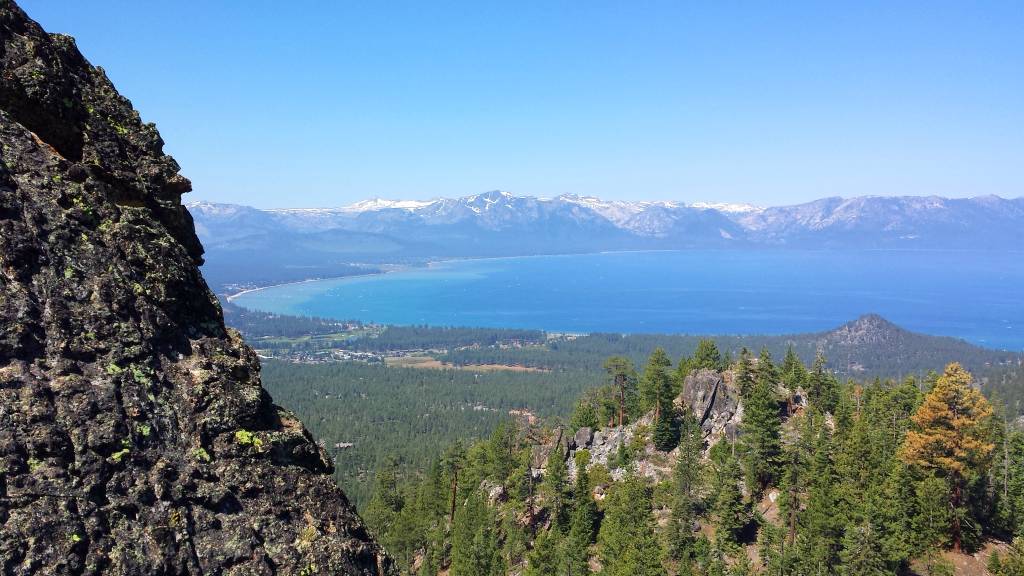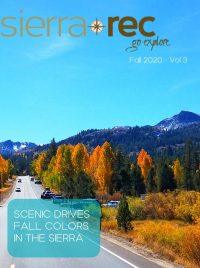Educational campaign works to create a balance between recreational uses and wildlife protection
STATELINE, Nev., 2020. – Lake Tahoe organizations working to harmonize wildlife protection and responsible recreation reported today a successful effort to protect fledgling peregrine falcons while still allowing access to popular hiking and climbing routes near the birds’ nesting sites. For the second year in a row, young peregrine falcons successfully left their nest at Castle Rock.
“The goal of this collaborative is to learn more about how the pair of falcons respond to different types of human presence so we can better tailor our management. This approach allows us to take the proper actions to protect the future of these birds while keeping the area open. We want to keep it open but encourage people to be mindful of what they’re doing and to be smart about how they’re recreating in the area,” said Stephanie Coppeto, wildlife biologist at the USDA Forest Service Lake Tahoe Basin Management Unit. “We’re thrilled that our collaboration has been able to increase public awareness and we appreciate the public’s cooperation in adhering to the signs and protecting these birds and their young.”
Peregrine falcons were once headed toward extinction. They were a charter member of the Endangered Species List, and today are considered a species of conservation priority by all wildlife jurisdictions at Tahoe due to their rarity and sensitivity to disturbance.

The USDA Forest Service Lake Tahoe Basin Management Unit, Tahoe Regional Planning Agency (TRPA), Nevada Department of Wildlife, California Tahoe Conservancy, Tahoe Institute for Natural Science (TINS), and Sierra Ecotone Solutions have monitored peregrine falcons as a special interest species dating back to 2009. Over the years of monitoring, falcon populations increased and expanded to new areas of the Basin like Castle Rock. Located in the southeast region of Lake Tahoe near Kingsbury Grade, the granite outcrop is an ideal nesting spot for the special bird. However, with excellent views of the lake, its popularity among climbers and hikers presented a new challenge for the raptors.
The Castle Rock nest successfully fledged for several years until 2017, when it failed for the first observed occurrence. That year, construction began at the trailhead to expand the parking lot, attracting more people to hike and climb and come in close contact with the falcons. The exact reason the nest failed, however, is unknown due to the myriad obstacles the birds must overcome before leaving the nest.
The following year, the collaboration brought on another partner, the Tahoe Climbing Coalition, who worked with the organizations to inform the climbing community to avoid routes closest to the nesting site. The climbing community obeyed these requests, but for the second year in a row the nest failed.
Things changed in 2019 when the collaboration conducted an experiment with staff who were monitoring the nests. They sent volunteers up the climbing and hiking routes nearest the nests while observing the falcons’ behavior. They discovered that hikers caused more distress than the climbers when they traveled above the birds’ nests. The question became: how do you protect the birds from disturbance and ensure compliance from hikers who frequented the area?
The solution was to educate hikers about the impacts their actions have on the young birds with signage along the many trails at the site. The Tahoe Rim Trail Association (TRTA) helped place signs requesting hikers not to summit Castle Rock until the birds have fledged. In addition, the Climbing Coalition’s influence among the climbing community helped encourage climbers to select other routes during the nesting season for the sake of the birds.
This spring and summer, as COVID-19 shelter-in-place orders drove people to spend more time outdoors, TINS noticed an immediate impact on the falcons when hikers returned to where they were nesting. The group was alerted and the partners sprang into action. The TRPA printed signs and installed them on the trail, and the nonprofit Tahoe Fund jumped in to help pay for the continuation of the monitoring by TINS. Normally, each partner contributes several monitoring visits per season to this unique site, but with COVID most of the partners were not able to get into the field during the critical spring months. With the support of the Tahoe Fund, TINS was able to keep the monitoring schedule on track and remove the signs as soon as the young fledged.
“Lifting the closure once it’s no longer needed each year gains the confidence of the hikers and climbers using the area, building trust that these voluntary closures are not arbitrary, which in turn leads to better compliance and better outcomes for the birds,” said Will Richardson, executive director of Tahoe Institute for Natural Science. “This was the first year they raised triplets!”
Learn more about Tahoe Institute for Natural Science and their work at tinsweb.org.









